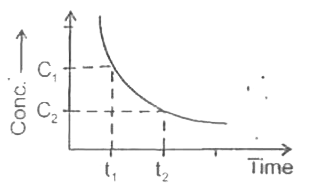For sperical mirros graph plotted between −1V and −1uis .
stright line with slope 1
straight line with slope -1
Parabola
none
The correct Answer is:B
To solve the problem of plotting the graph between −1V and −1u for spherical mirrors, we can follow these steps:
1. Understand the Mirror Formula:
The mirror formula for spherical mirrors is given by:
1f=1v+1u
where f is the focal length, v is the image distance, and u is the object distance.
2. Rearranging the Equation:
We can rearrange the mirror formula to express it in terms of −1V and −1u:
1v=1f−1u
Multiplying the entire equation by −1:
−1v=−1f+1u
This can be rewritten as:
−1v+1u=−1f
3. Substituting Variables:
Let:
X=−1vandY=−1u
Therefore, we can rewrite the equation as:
X+Y=−1f
4. Identifying the Equation of a Line:
The equation X+Y=−1f can be rearranged to:
Y=−X−1f
This is in the form of Y=mX+c, where m is the slope and c is the y-intercept.
5. Determining the Slope:
From the equation Y=−X−1f, we can see that the slope m=−1.
6. Conclusion:
Since the graph of −1V versus −1u is a straight line with a slope of −1, the correct answer to the question is that the graph is a straight line with a slope of −1.
Final Answer:
The graph plotted between −1V and −1u is a straight line with a slope of −1.
---
The mirror formula for spherical mirrors is given by:
1f=1v+1u
where f is the focal length, v is the image distance, and u is the object distance.
We can rearrange the mirror formula to express it in terms of −1V and −1u:
1v=1f−1u
Multiplying the entire equation by −1:
−1v=−1f+1u
This can be rewritten as:
−1v+1u=−1f
Let:
X=−1vandY=−1u
Therefore, we can rewrite the equation as:
X+Y=−1f
The equation X+Y=−1f can be rearranged to:
Y=−X−1f
This is in the form of Y=mX+c, where m is the slope and c is the y-intercept.
From the equation Y=−X−1f, we can see that the slope m=−1.
Since the graph of −1V versus −1u is a straight line with a slope of −1, the correct answer to the question is that the graph is a straight line with a slope of −1.
The graph plotted between −1V and −1u is a straight line with a slope of −1.
Topper's Solved these Questions
- EXPERIMENTAL PHYSICSBOOK - RESONANCE ENGLISHCHAPTER - EXPERIMENTAL PHYSICSEXERCISE - Exercise -1 PART
1 Videos
- EXPERIMENTAL PHYSICSBOOK - RESONANCE ENGLISHCHAPTER - EXPERIMENTAL PHYSICSEXERCISE - PART II
13 Videos
- EXPERIMENTAL PHYSICSBOOK - RESONANCE ENGLISHCHAPTER - EXPERIMENTAL PHYSICSEXERCISE - PART -II
10 Videos
- ELECTROSTATICSBOOK - RESONANCE ENGLISHCHAPTER - ELECTROSTATICSEXERCISE - HLP
40 Videos
- GEOMATRICAL OPTICS BOOK - RESONANCE ENGLISHCHAPTER - GEOMATRICAL OPTICS EXERCISE - Advance level Problems
35 Videos
Similar Questions
For a concave mirrorr, if real image is formed the graph between 1u and 1v is of the form
View SolutionFor an ideal solution, if a graph is plotted between 1PT and yA (mole fraction of A in vapour phase) where p0A>p0B then
View SolutionAt constant temperature if a graph plotted between logP and log(1V) has an intercept of unity then what will be the value of constant (k)
View SolutionIn Searl's experiment a graph is plotted between
View SolutionThe graph between 1v and 1u for a concave mirror looks like.
View SolutionThe graph between 1v and 1u for a concave mirror looks like.
View SolutionWhat do we get for a plot between V and 1/P ?
View SolutionThe graph plotted between concentration versus time

View SolutionIn determining the angle of minimum deviation for a given prism, a graph is plotted between the angle of incidence (j) and the angle of deviation (δ). Which of the following graphs will correctly
View SolutionA graph is plotted between Ecell and log.[Zn2+][Cu2+] . The curve is linear with intercept on Ecell axis equals to 1.10V. Calculate Ecell for the cell.
Zn(s)∣∣∣∣Zn2+(0.1M)∣∣∣∣Cu2+(0.01M)∣Cu
View Solution
